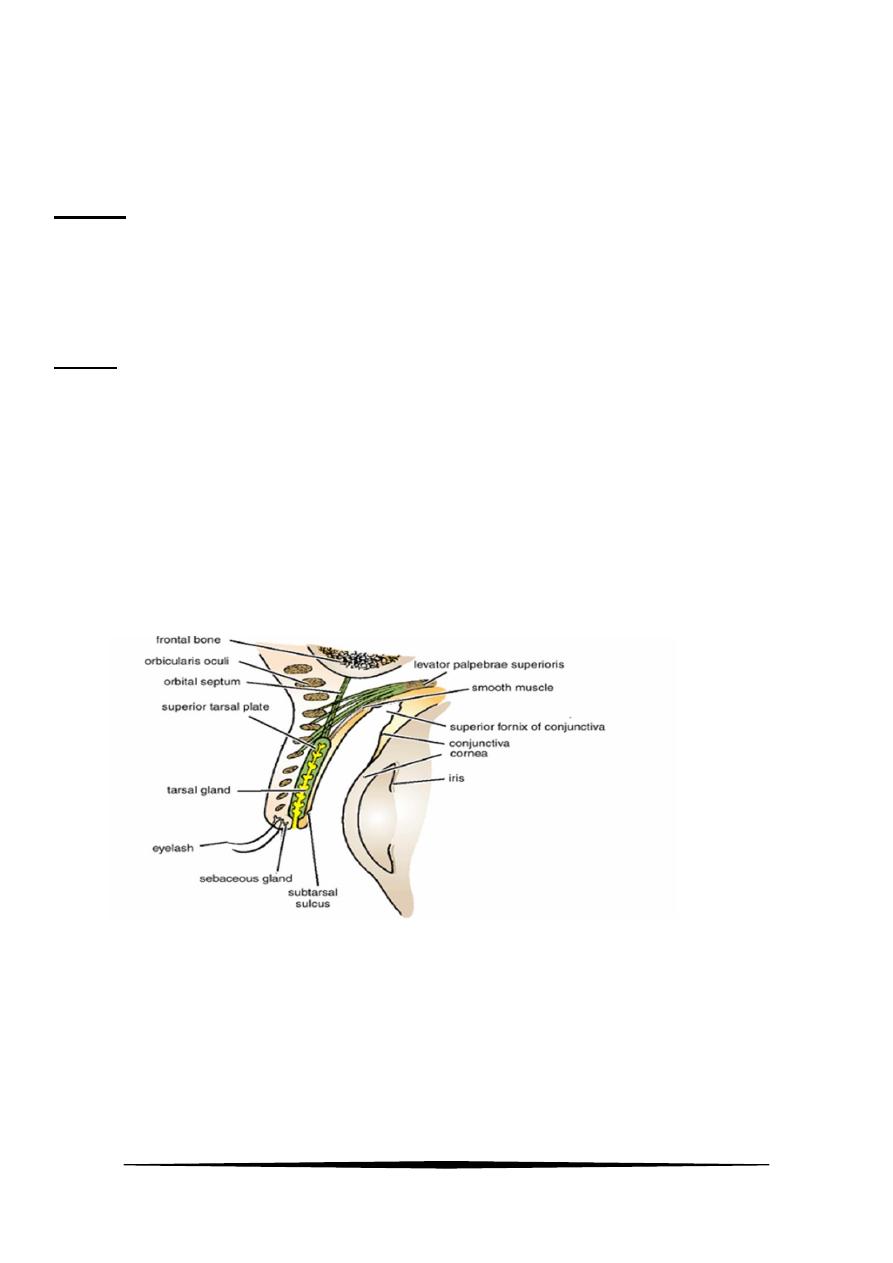
1
Anatomy of Orbit and Eye
Dr. Muataz Hasan
Orbit
Orbital Region
The orbits are a pair of bony cavities that contain the eyeballs; their associated muscles,
nerves, vessels, and fat; and most of the lacrimal apparatus.
Eyelids
The eyelids protect the eye from injury and excessive light by their closure. The upper eyelid
is larger and more mobile than the lower, and they meet each other at the medial and lateral
angles.
The superficial surface of the eyelids is covered by skin, and the deep surface is
covered by a mucous membrane, called the conjunctiva. The eyelashes are short,
curved hairs on the free edges of the eyelids. They are arranged in double or triple
rows at the mucocutaneous junction.
The sebaceous glands (glands of Zeis) open directly into the eyelash follicles. The
ciliary glands (glands of Moll) are modified sweat glands that open separately
between adjacent lashes. The tarsal glands are long, modified sebaceous glands that
pour their oily secretion onto the margin of the lid; their openings lie behind the
eyelashes.
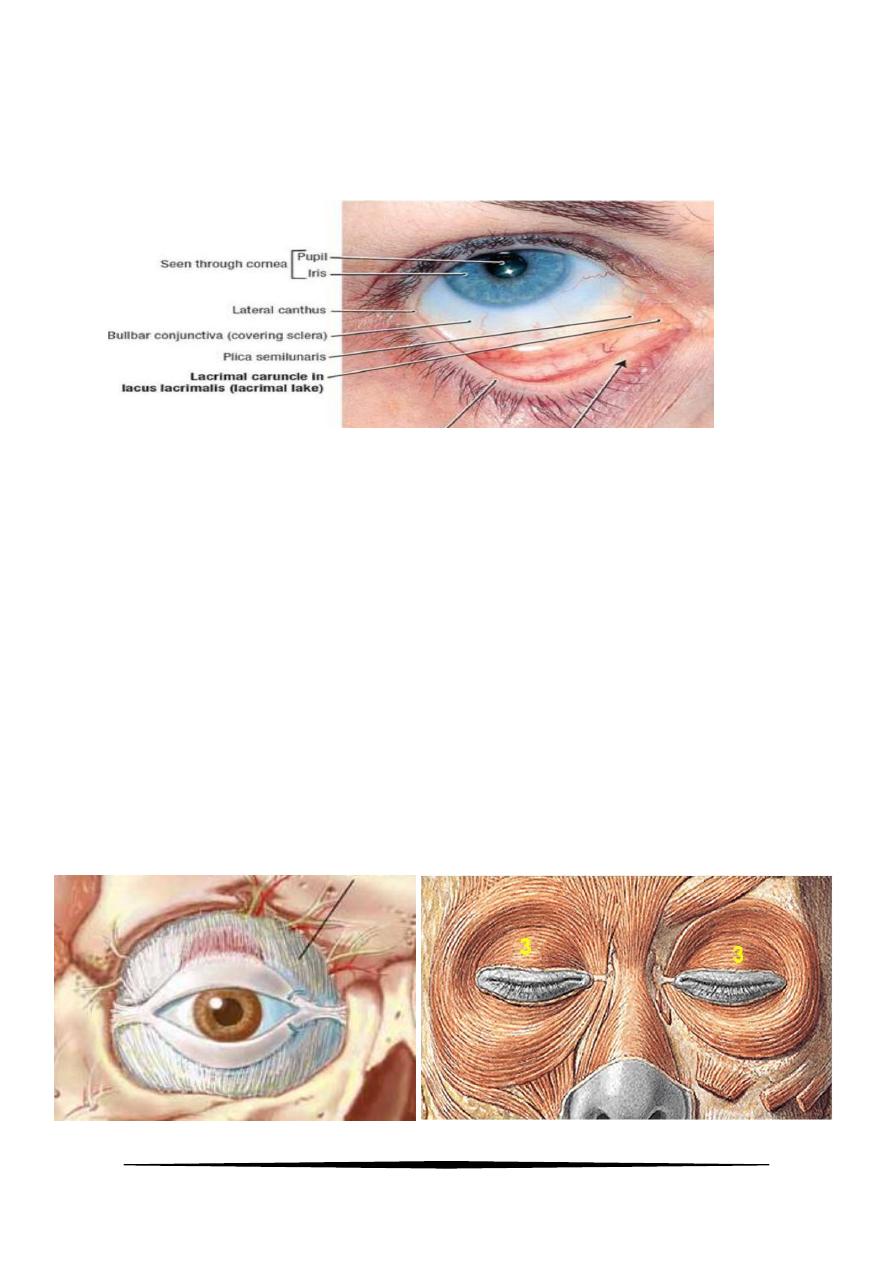
2
The more rounded medial angle is separated from the eyeball by a small space, the
lacus lacrimalis, in the center of which is a small, reddish yellow elevation, the
caruncula lacrimalis . A reddish semilunar fold, called the plica semilunaris, lies on
the lateral side of the caruncle.
Near the medial angle of the eye a small elevation, the papilla lacrimalis, is present.
On the summit of the papilla is a small hole, the punctum lacrimale, which leads into
the canaliculus lacrimalis. The papilla lacrimalis projects into the lacus, and the
punctum and canaliculus carry tears down into the nose.
The conjunctiva is a thin mucous membrane that lines the eyelids and is reflected at the
superior and inferior fornices onto the anterior surface of the eyeball.
The framework of the eyelids is formed by a fibrous sheet, the orbital septum. This is
attached to the periosteum at the orbital margins. The orbital septum is thickened at the
margins of the lids to form the superior and inferior tarsal plates. The lateral ends of the
plates are attached by a band, the lateral palpebral ligament, to lacrimal bone a bony
tubercle just within the orbital margin. The medial ends of the plates are attached by a band,
the medial palpebral ligament, to the crest of the lacrimal bone.
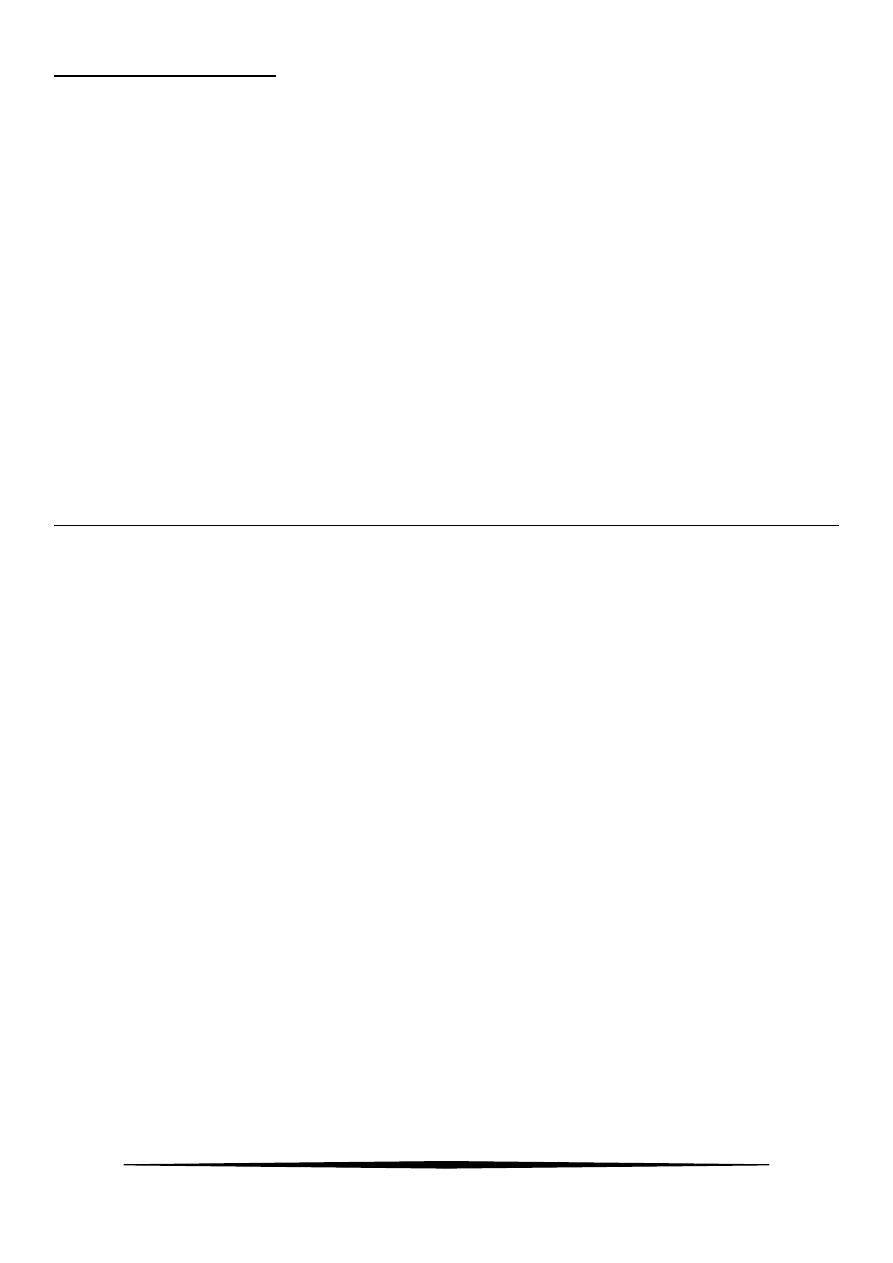
3
Movements of the Eyelids
The position of the eyelids at rest depends on the tone of the orbicularis oculi and the levator
palpebrae superioris muscles and the position of the eyeball. The eyelids are closed by the
contraction of the orbicularis oculi and the relaxation of the levator palpebrae superioris
muscles. The eye is opened by the levator palpebrae superioris raising the upper lid. On
looking upward, the levator palpebrae superioris contracts, and the upper lid moves with the
eyeball. On looking downward, both lids move, the upper lid continues to cover the upper
part of the cornea, and the lower lid is pulled downward slightly by the conjunctiva, which is
attached to the sclera and the lower lid.
Muscles of the Eyeball and Eyelids
Muscle
Origin
Insertion
Nerve Supply
Action
Extrinsic Muscles of Eyeball (Striated Skeletal Muscle)
Superior
rectus
Tendinous
ring on
posterior
wall of
orbital
cavity
Superior
surface of
eyeball just
posterior to
corneoscleral
junction
Oculomotor
nerve (third
cranial nerve)
Raises cornea
upward and
medially
Inferior
rectus
Tendinous
ring on
posterior
wall of the
orbit
Inferior surface
of eyeball just
posterior to
corneoscleral
junction
Oculomotor
nerve (third
cranial nerve)
Depresses cornea
downward and
medially
Medial
rectus
Tendinous
ring on
posterior
wall of the
orbit
Medial surface
of eyeball just
posterior to
corneoscleral
junction
Oculomotor
nerve (third
cranial nerve)
Rotates eyeball so
that cornea looks
medially

4
Lateral
rectus
Tendinous
ring on
posterior
wall of the
orbit
Lateral surface
of eyeball just
posterior to
corneoscleral
junction
Abducent nerve
(sixth cranial
nerve)
Rotates eyeball so
that cornea looks
laterally
Superior
oblique
Posterior
wall of
orbital
cavity
Passes through
pulley and is
attached to
superior surface
of eyeball
beneath superior
rectus
Trochlear nerve
(fourth cranial
nerve)
Rotates eyeball so
that cornea looks
downward and
laterally
Inferior
oblique
Floor of
orbital
cavity
Lateral surface
of eyeball deep
to lateral rectus
Oculomotor
nerve (third
cranial nerve)
Rotates eyeball so
that cornea looks
upward and
laterally
Intrinsic Muscles of Eyeball (Smooth Muscle)
Sphincter
pupillae of
iris
Parasympathetic
via oculomotor
nerve
Constricts pupil
Dilator
pupillae of
iris
Sympathetic
Dilates pupil
Ciliary
muscle
Parasympathetic
via oculomotor
nerve
Controls shape of
lens; in
accommodation,
makes lens more
globular
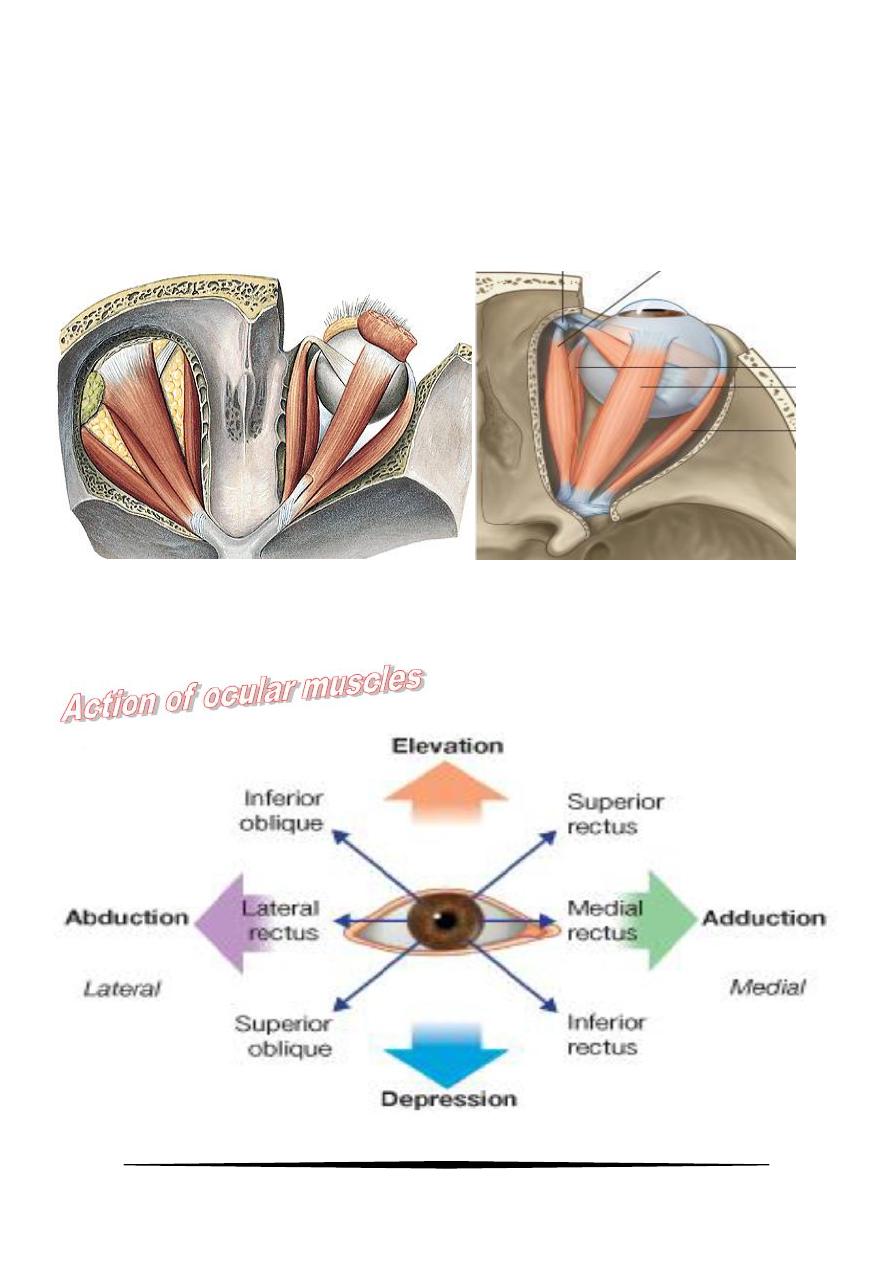
5
Muscles of Eyelids
Levator
palpebrae
superioris
Back of
orbital
cavity
Anterior surface
and upper margin
of superior tarsal
plate
Striated muscle
oculomotor nerve,
smooth muscle
sympathetic
Raises upper lid
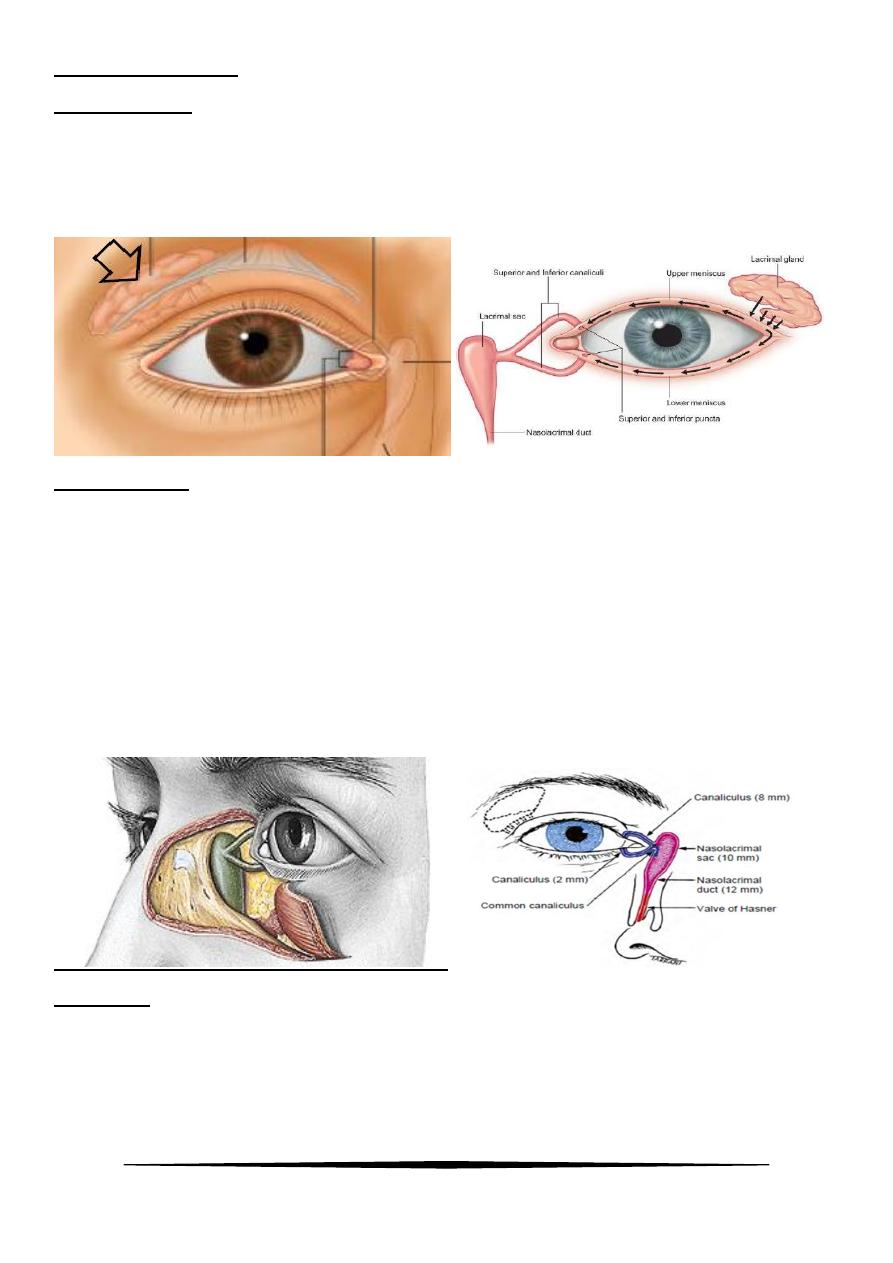
6
Lacrimal Apparatus
Lacrimal Gland
The lacrimal gland consists of a large orbital part and a small palpebral part, It is situated
above the eyeball in the anterior and upper part of the orbit posterior to the orbital septum.
The gland opens into the lateral part of the superior fornix of the conjunctiva by 12 ducts.
Lacrimal Ducts
The tears circulate across the cornea and accumulate in the lacus lacrimalis. From here, the
tears enter the canaliculi lacrimales through the puncta lacrimalis. The canaliculi lacrimales
pass medially and open into the lacrimal sac which lies in the lacrimal groove behind the
medial palpebral ligament and is the upper blind end of the nasolacrimal duct.
The nasolacrimal duct is about (1.3 cm) long and emerges from the lower end of the lacrimal
sac. The duct descends downward, backward, and laterally in a bony canal and opens into the
inferior meatus of the nose.
Bony Orbit
The orbit is a pyramidal cavity with its base in front and its apex behind. The orbital margin
is formed above by the frontal bone, the lateral margin is formed by the processes of the
frontal and zygomatic bones, the inferior margin is formed by the zygomatic bone and the
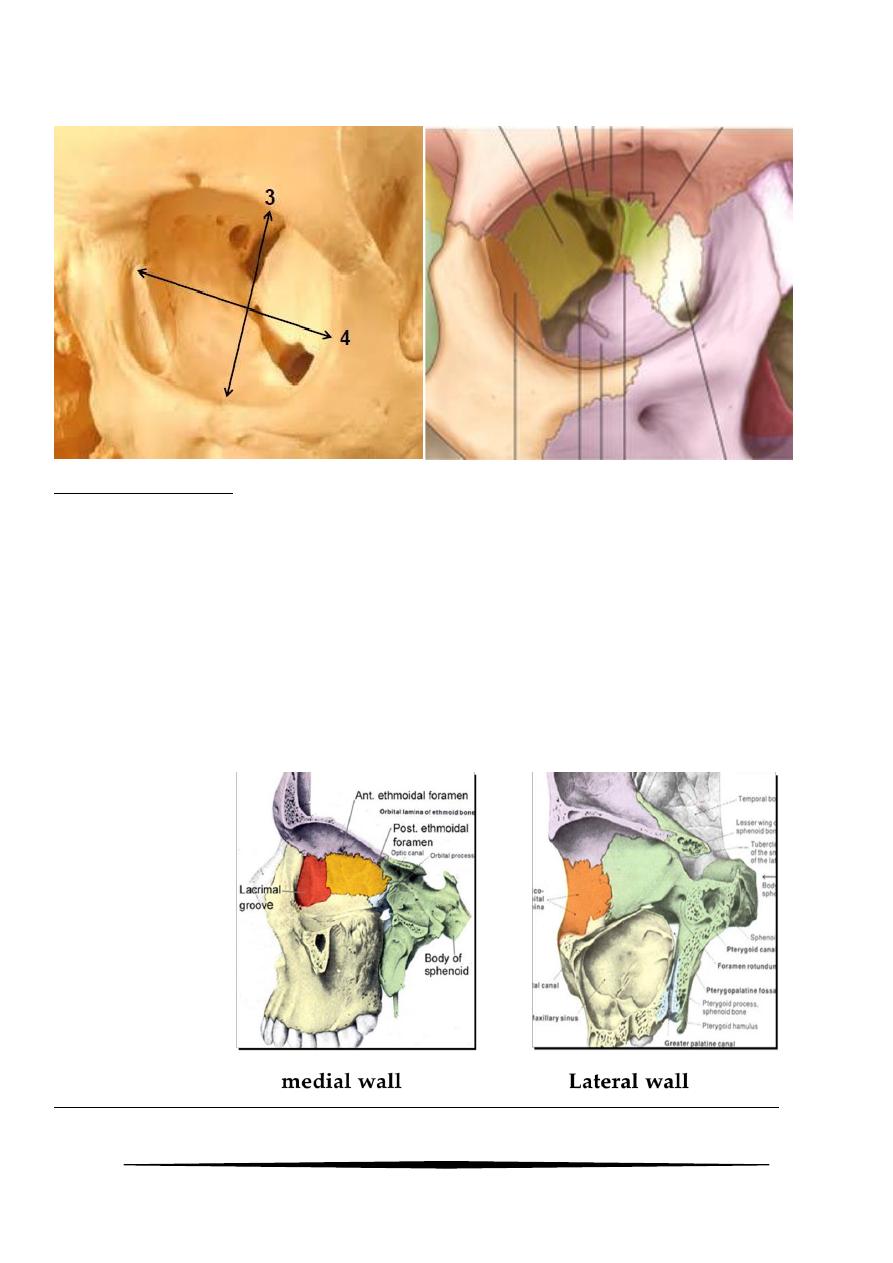
7
maxilla, and the medial margin is formed by the processes of the maxilla and the frontal
bone.
The orbital walls are:
The Roof: it is made of two bones; the lesser wing of sphenoid and the orbital plate of
the frontal bone, located subjacent to the anterior cranial fossa.
The Lateral Wall: it is made of two bones; the greater wing of the sphenoid and
zygomatic bone.
The Floor: it is made of three bones; the zygomatic, maxillary (both form the anterior
2/3) and palatine (forms posterior 1/3) bones.
The Medial Wall: It is made of four bones; the maxilla (frontal process), lacrimal,
ethmoid and the body of sphenoid.
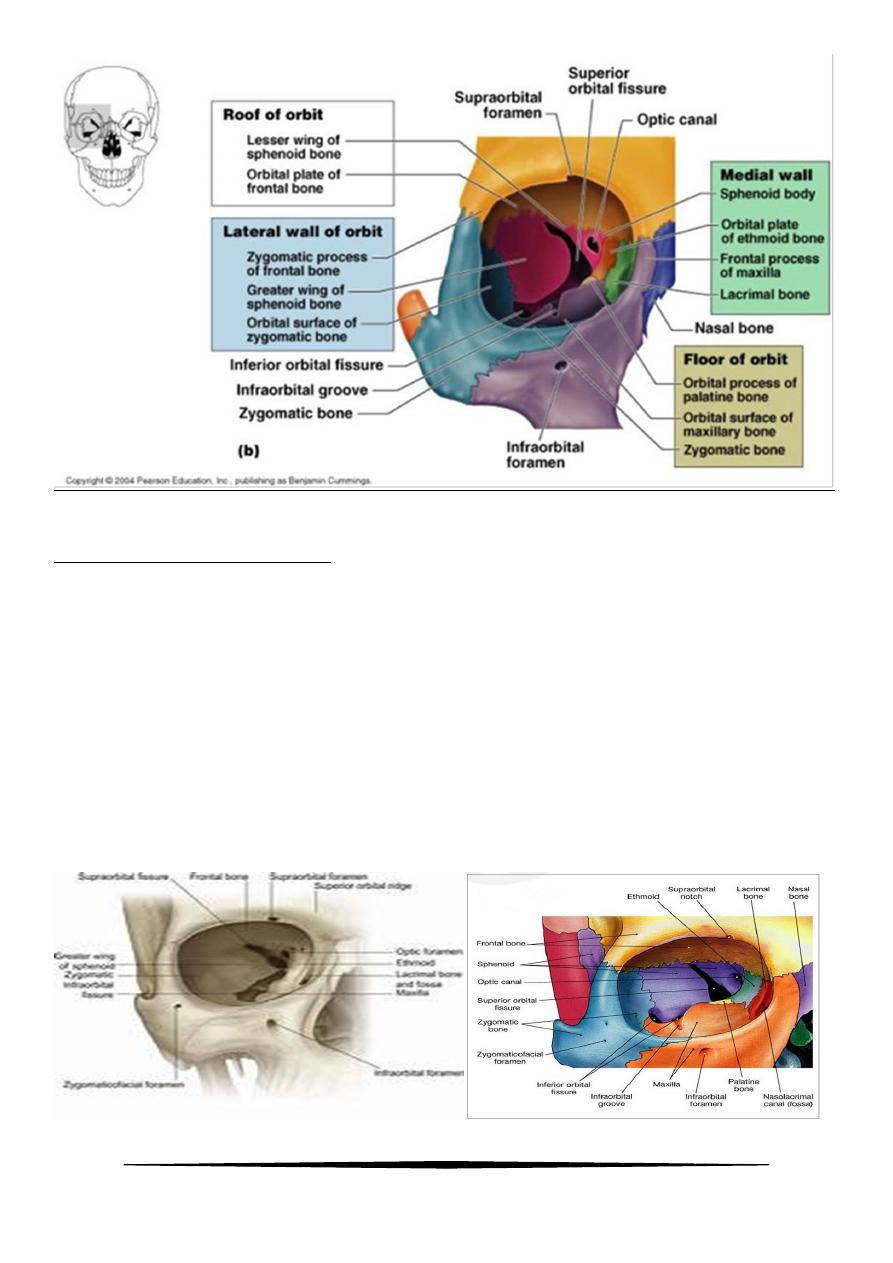
8
Openings Into the Orbital Cavity
Orbital opening: Lies anteriorly. About one-sixth of the eye is exposed; the remainder
is protected by the walls of the orbit.
Supraorbital notch (Foramen): The supraorbital notch is situated on the superior
orbital margin. It transmits the supraorbital nerve and blood vessels.
Infraorbital groove and canal: Situated on the floor of the orbit in the orbital plate of
the maxilla; they transmit the infraorbital nerve (a continuation of the maxillary nerve)
and blood vessels.
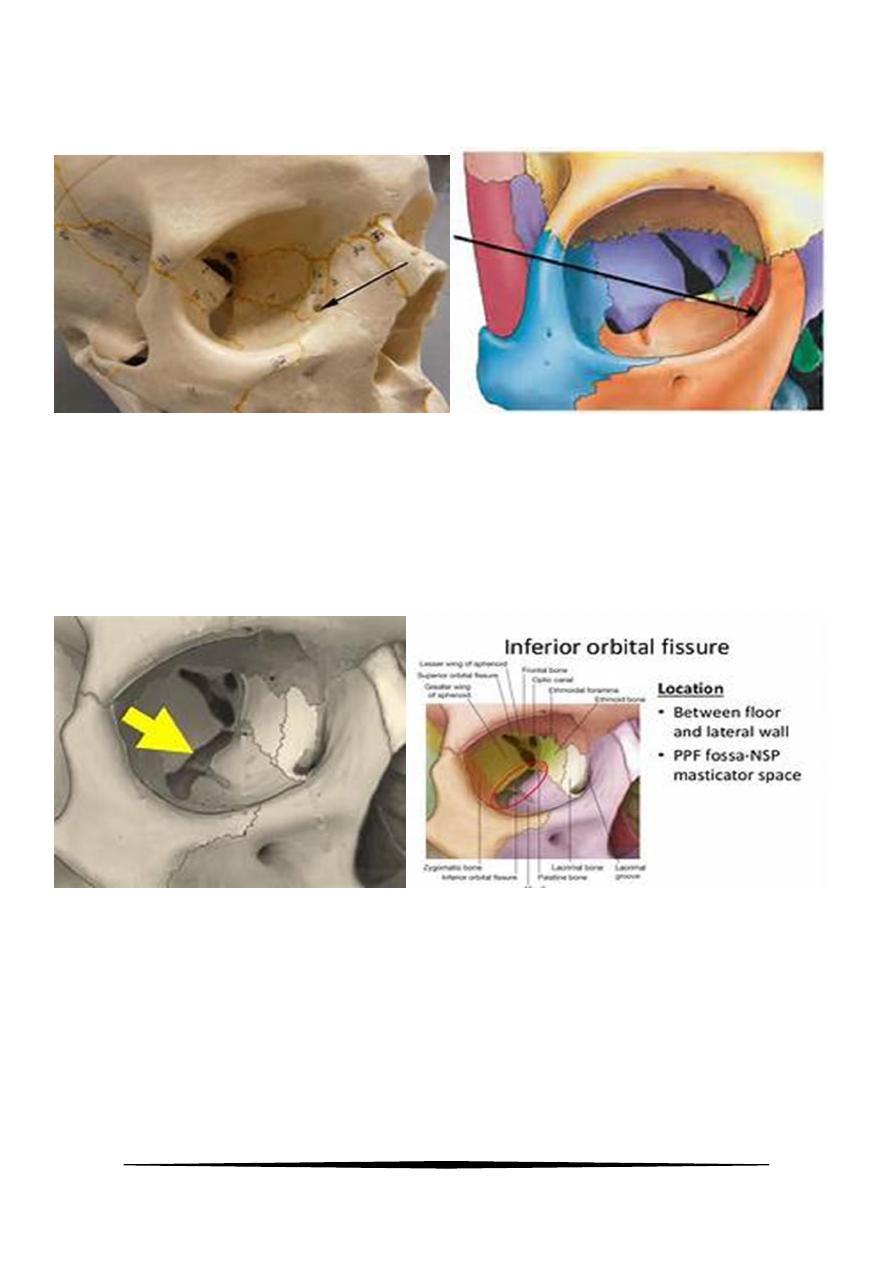
9
Nasolacrimal canal: Located anteriorly on the medial wall; it communicates with the
inferior meatus of the nose. It transmits the nasolacrimal duct.
Inferior orbital fissure: Located posteriorly between the maxilla and the greater wing
of the sphenoid; it communicates with the pterygopalatine fossa. It transmits the
maxillary nerve and its zygomatic branch, the inferior ophthalmic vein, and
sympathetic nerves.
Superior orbital fissure: Located posteriorly between the greater and lesser wings of
the sphenoid; it communicates with the middle cranial fossa. It transmits the lacrimal
nerve, the frontal nerve, the trochlear nerve, the oculomotor nerve (upper and lower
divisions), the abducent nerve, the nasociliary nerve, and the superior ophthalmic vein.
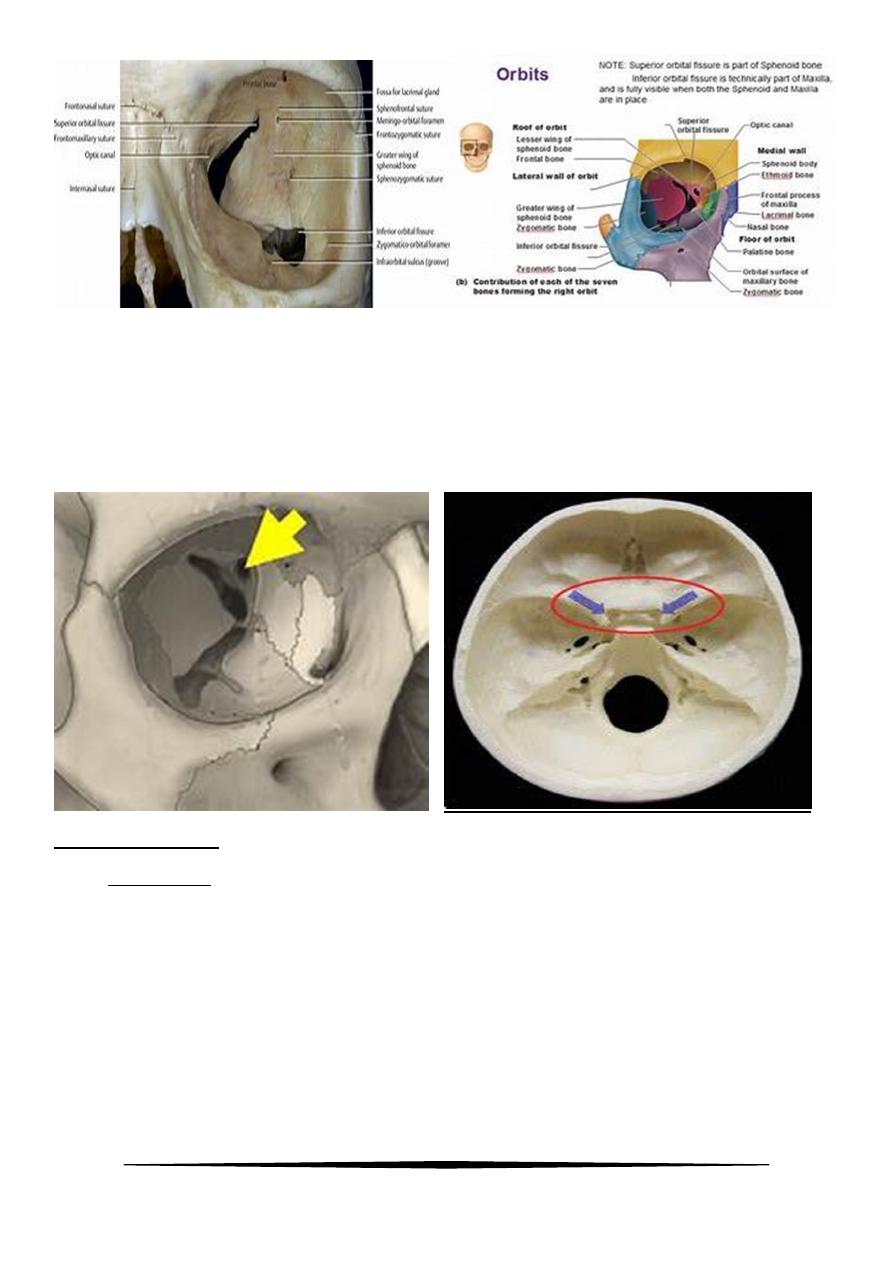
11
Optic canal: Located posteriorly in the lesser wing of the sphenoid; it communicates
with the middle cranial fossa. It transmits the optic nerve and the ophthalmic artery.
Nerves of the Orbit
Optic Nerve
The optic nerve enters the orbit from the middle cranial fossa by passing through the optic
canal. It is accompanied by the ophthalmic artery. The nerve is surrounded by sheaths of pia
mater, arachnoid mater, and dura mater. It runs forward and laterally within the cone of the
recti muscles and pierces the sclera at a point medial to the posterior pole of the eyeball.
Here, the meninges fuse with the sclera so that the subarachnoid space with its contained
cerebrospinal fluid extends forward from the middle cranial fossa, around the optic nerve,
and through the optic canal.
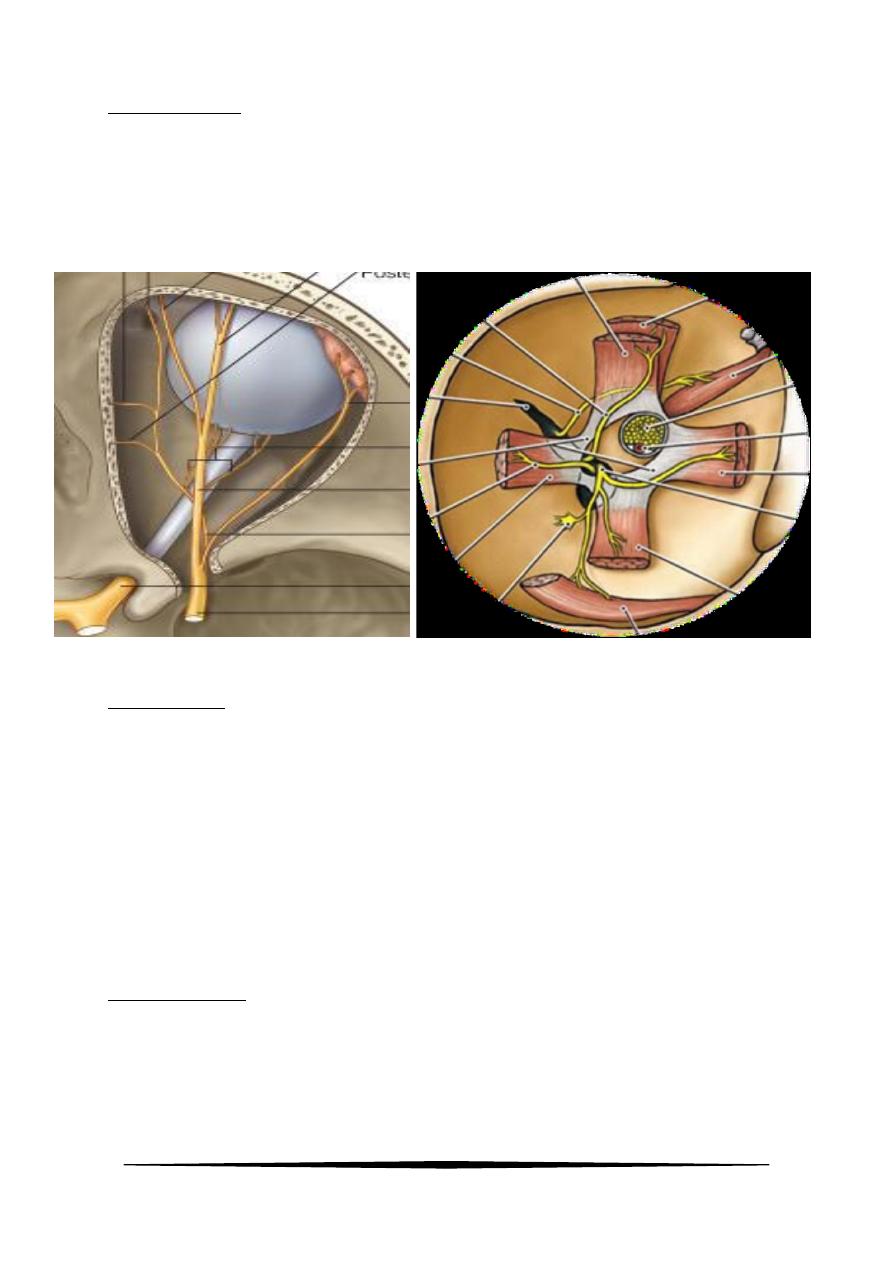
11
Lacrimal Nerve
The lacrimal nerve arises from the ophthalmic division of the trigeminal nerve. It enters the
orbit through the upper part of the superior orbital fissure and passes forward along the upper
border of the lateral rectus muscle. It is joined by a branch of the zygomaticotemporal nerve,
which later leaves it to enter the lacrimal gland
Frontal Nerve
The frontal nerve arises from the ophthalmic division of the trigeminal nerve. It enters the
orbit through the upper part of the superior orbital fissure and passes forward on the upper
surface of the levator palpebrae superioris beneath the roof of the orbit. It divides into the
supratrochlear and supraorbital nerves that wind around the upper margin of the orbital
cavity to supply the skin of the forehead; the supraorbital nerve also supplies the mucous
membrane of the frontal air sinus.
Trochlear Nerve
The trochlear nerve enters the orbit through the upper part of the superior orbital fissure. It
runs forward and supplies the superior oblique muscle.
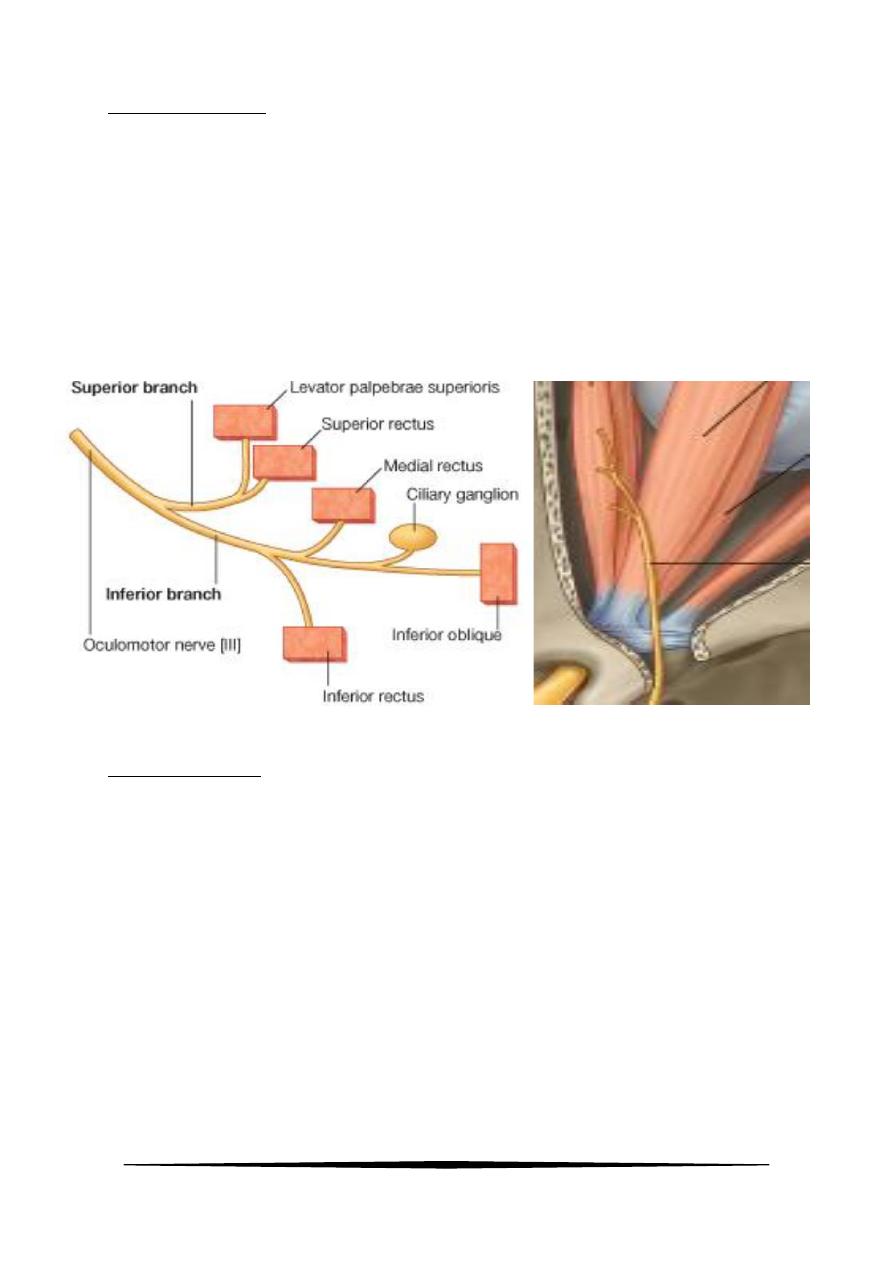
12
Oculomotor Nerve
The superior ramus of the oculomotor nerve enters the orbit through the lower part of the
superior orbital fissure. It supplies the superior rectus muscle, then pierces it, and supplies
the levator palpebrae superioris muscle.
The inferior ramus of the oculomotor nerve enters the orbit in a similar manner and supplies
the inferior rectus, the medial rectus, and the inferior oblique muscles. The nerve to the
inferior oblique gives off a branch that passes to the ciliary ganglion and carries
parasympathetic fibers to the sphincter pupillae and the ciliary muscle.
Nasociliary Nerve
The nasociliary nerve arises from the ophthalmic division of the trigeminal nerve. It enters
the orbit through the lower part of the superior orbital fissure. It crosses above the optic
nerve, runs forward along the upper margin of the medial rectus muscle, and ends by
dividing into the anterior ethmoidal and infratrochlear nerves.
Branches of the Nasociliary Nerve
The communicating branch to the ciliary ganglion is a sensory nerve.
The long ciliary nerves, two or three in number, arise from the nasociliary nerve as it
crosses the optic nerve.
The posterior ethmoidal nerve supplies the ethmoidal and sphenoidal air sinuses.
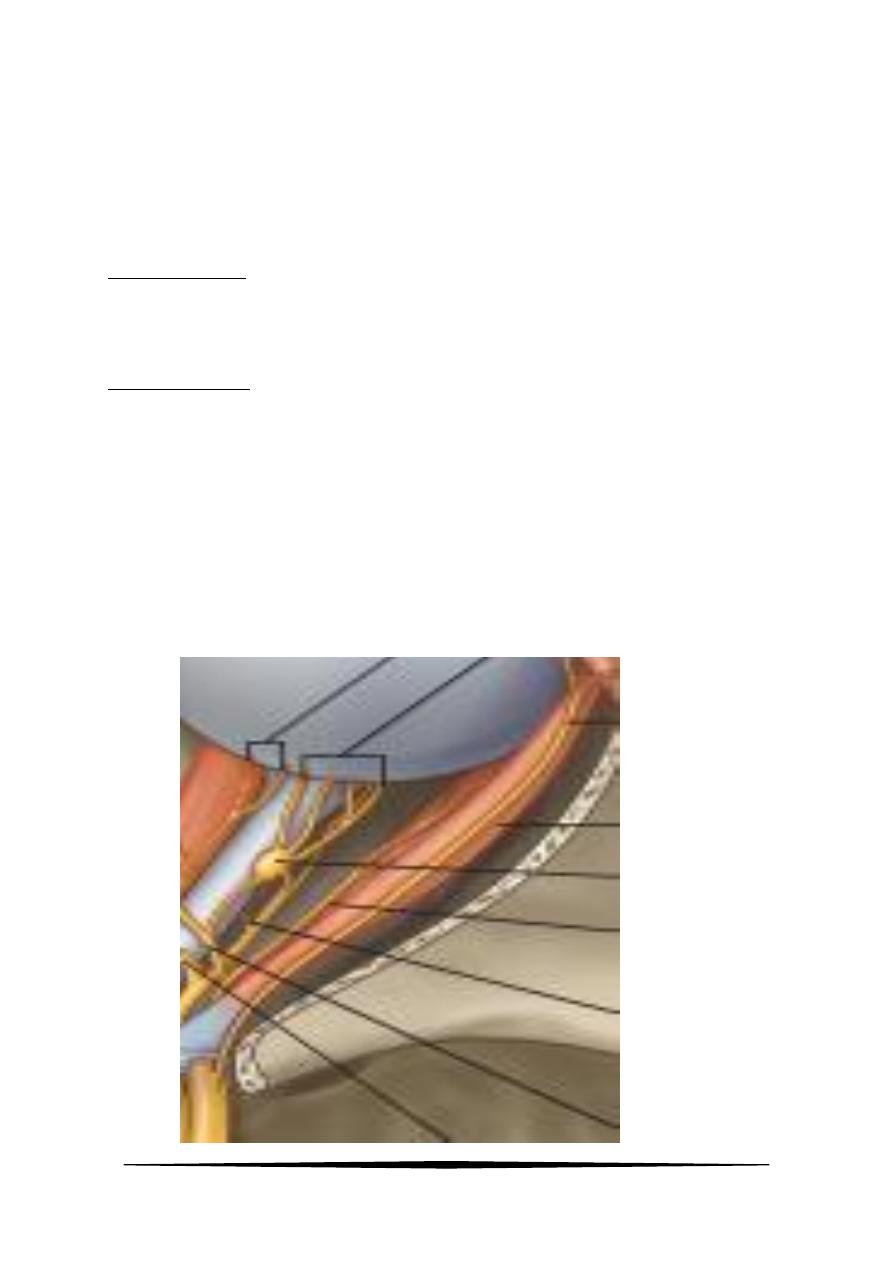
13
The infratrochlear nerve passes forward below the pulley of the superior oblique
muscle and supplies the skin of the medial part of the upper eyelid and the adjacent
part of the nose.
The anterior ethmoidal nerve passes through the anterior ethmoidal foramen and enters
the anterior cranial fossa on the upper surface of the cribriform plate of the ethmoid.
Abducent Nerve
The abducent nerve enters the orbit through the lower part of the superior orbital fissure. It
supplies the lateral rectus muscle.
Ciliary Ganglion
The ciliary ganglion is a parasympathetic ganglion about the size of a pinhead and situated in
the posterior part of the orbit. It receives its preganglionic parasympathetic fibers from the
oculomotor nerve via the nerve to the inferior oblique. The postganglionic fibers leave the
ganglion in the short ciliary nerves, which enter the back of the eyeball and supply the
sphincter pupillae and the ciliary muscle.
A number of sympathetic fibers pass from the internal carotid plexus into the orbit and run
through the ganglion without interruption.
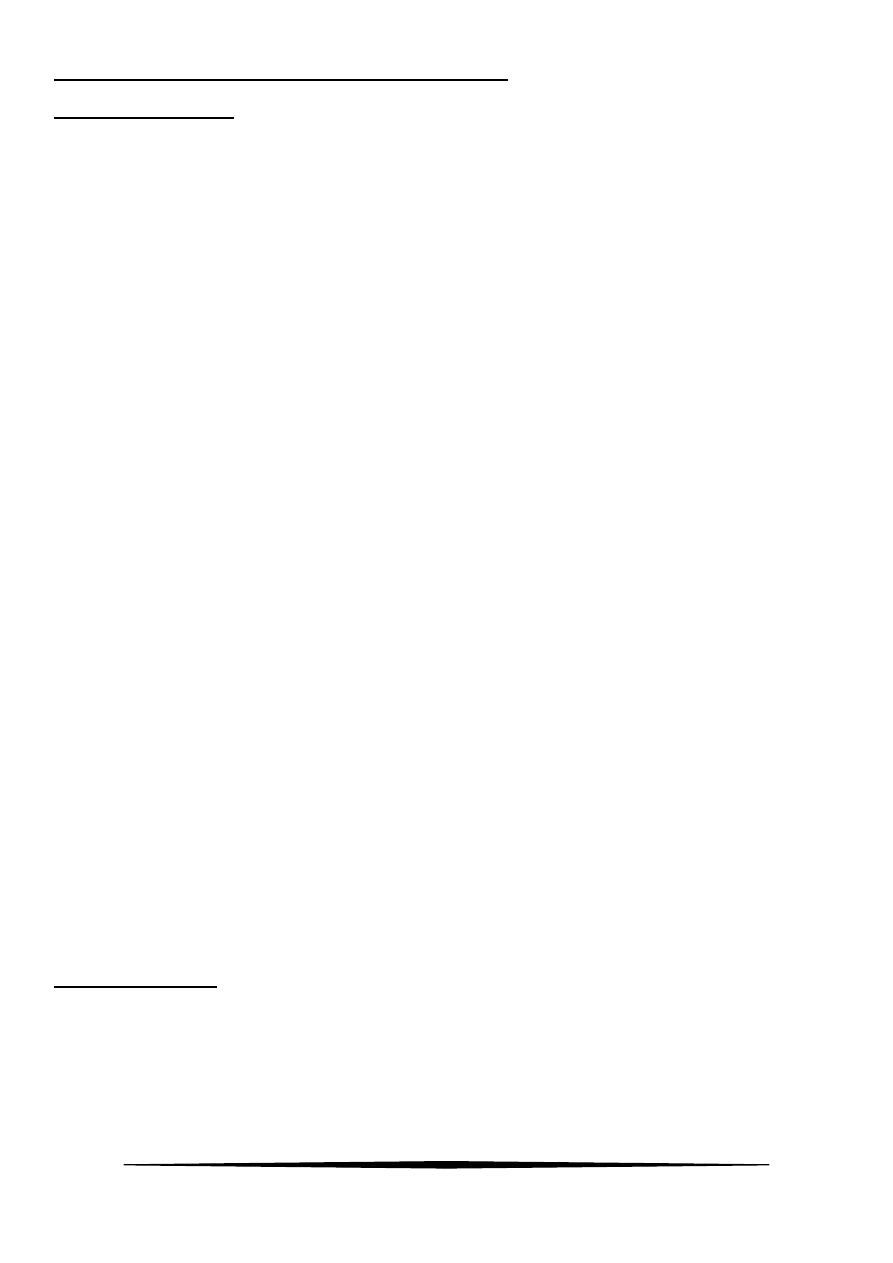
14
Blood Vessels and Lymph Vessels of the Orbit
Ophthalmic Artery:
It is a branch from the internal carotid artery as it emerges from the cavernous sinus.
It passes forward and enters the orbit through the optic canal below the optic nerve. In the
orbit, at first it lies below the optic nerve then pierces the arachnoid and the dural sheaths and
winding round the lateral side of the optic nerve, then it crosses above the nerve with the
nasociliary nerve to reach the medial side of the orbit.
It runs forwards along the medial wall of the orbit between the medial rectus and the superior
oblique, and terminates near the medial angle of the eye by dividing into the supratroclear
artery and the dorsal nasal artery.
Branches:
1. Branches to the eyeball
o central artery of the retina.
o posterior ciliary branches [2 long and 7 short].
2. Branches to the orbital muscles: muscular branches
3. Branch along the lateral wall of the orbit: lacrimal artery to the lacrimal gland
4. Branches along the medial wall of the orbit:
o Posterior ethmoidal artery.
o Anterior ethmoidal artery.
o Supraorbital artery.
o Supratrochlear artery .
o Dorsal nasal artery.
o Medial palpebral artery.
Ophthalmic Veins
1. Superior ophthalmic vein: it begins in the anterior part of the orbit close to the
ophthalmic artery, and then it runs with this artery. It communicates with supra-orbital
tributaries of the facial vein.
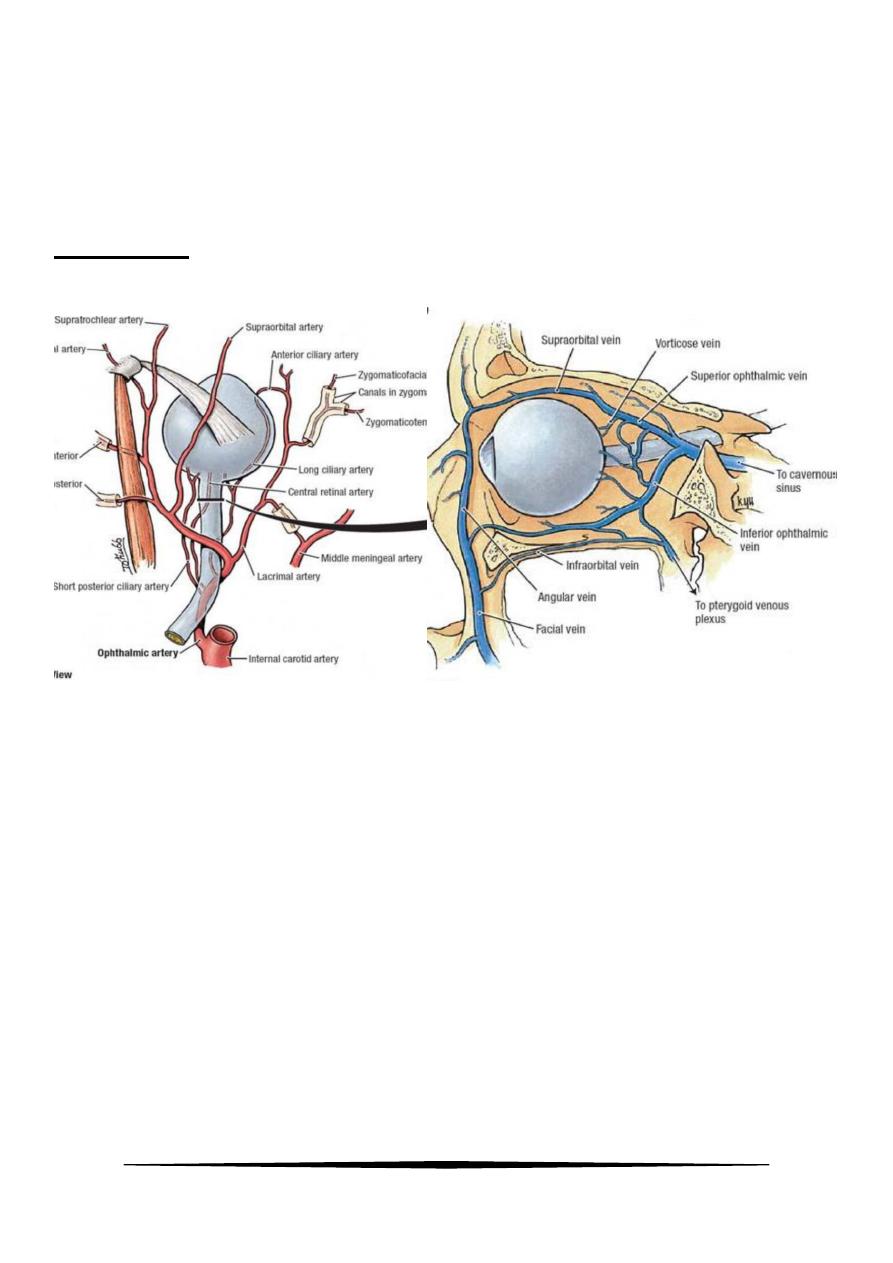
15
2. Inferior ophthalmic vein: is smaller than superior ophthalmic vein and lies below the
optic nerve. It communicates with pterygoid venous plexus by small vein through the
inferior orbital fissure.
Both veins pass through the superior orbital fissure and drain into the cavernous sinus.
Lymph Vessels
No lymph vessels or nodes are present in the orbital cavity.
Orbital fascia:
It is the periosteum of the bones that form the walls of the orbit. It is loosely attached to the
bones and is continuous with the periosteum covering the outer surface of the bones through
the foramina and the fissures. It encloses all the contents of the orbit except the zygomatic
nerve and the infra-orbital nerve and vessels.
Bulbar fascia [fascial sheath of the eyeball]:
It forms a thin membranous socket around the eyeball [but is deficient in front over the
cornea]. It is separated from the eyeball by soft, semifluid tissue which allows the eyeball to
slide freely in the sheath. The free anterior margin fuses with the conjunctiva close to the
margin of the cornea, while the posterior margin fuses with the dural sheath of the optic
nerve.
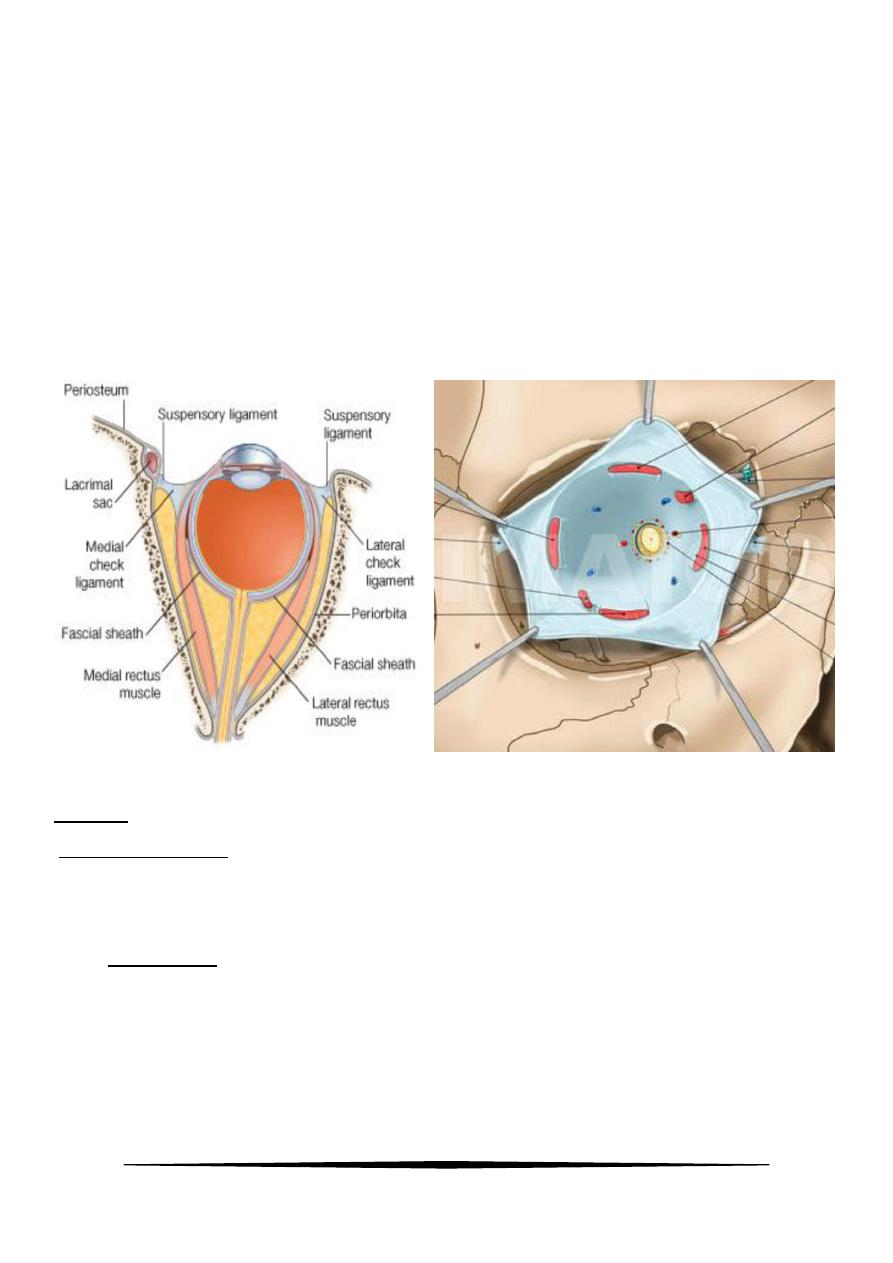
16
This fascia separates the eyeball from the orbital fat and form a tubular sheaths covering
each orbital muscle. Each of the extraocular muscles pierces the fascial sheath at the equator
of the eyeball and receives covering sleeve with it. These sleeves prevent the muscles
compressing the eyeball when it contracts.
The facial sheath is connected to the orbital walls by:
1. Lateral and medial check ligaments: these are strong bands pass from the sheaths around
the lateral and medial rectus to the medial and lateral walls.
2. The suspensory ligament: it is a sling stretched across the anterior part of the orbit
between the lateral and medial check ligaments.
The Eye
Structure of the Eye
consists of three coats, the fibrous coat, the vascular pigmented coat, and the nervous coat.
Fibrous Coat
The fibrous coat is made up of a posterior opaque part, the sclera, and an anterior transparent
part, the cornea
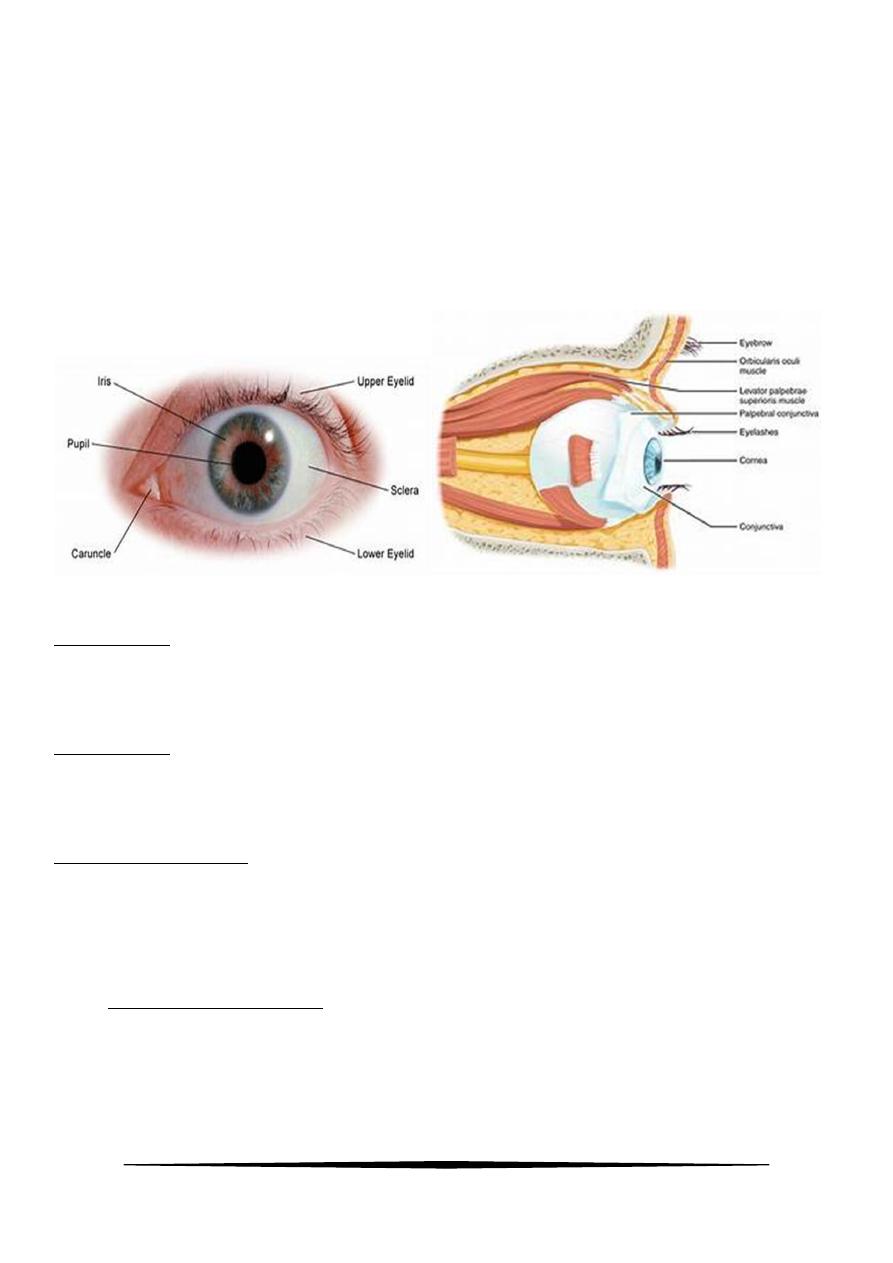
17
Sclera
The opaque sclera is composed of dense fibrous tissue and is white. Posteriorly, it is pierced
by the optic nerve and is fused with the dural sheath of that nerve. The sclera is directly
continuous in front with the cornea at the corneoscleral junction, or limbus.
Cornea
The transparent cornea is largely responsible for the refraction of the light entering the eye. It
is in contact posteriorly with the aqueous humor.
Blood Supply
The cornea is avascular and devoid of lymphatic drainage. It is nourished by diffusion from
the aqueous humor and from the capillaries at its edge.
Nerve Supply
Long ciliary nerves from the ophthalmic division of the trigeminal nerve
Function of the Cornea
The cornea is the most important refractive medium of the eye. This refractive power occurs
on the anterior surface of the cornea.
Vascular Pigmented Coat
The vascular pigmented coat consists, from behind forward, the choroid, the ciliary body,
and the iris.
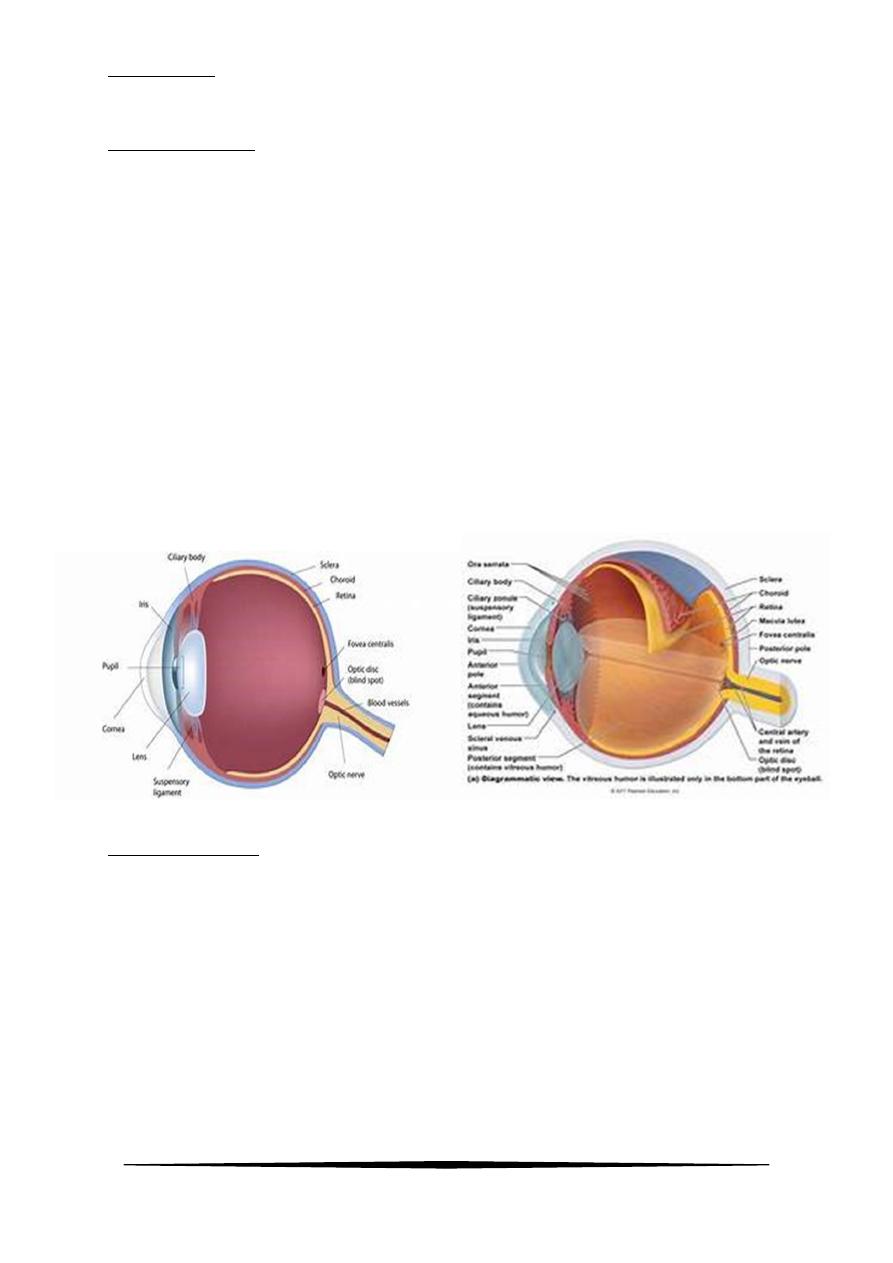
18
The Choroid
The choroid is composed of an outer pigmented layer and an inner, highly vascular layer.
The Ciliary Body
The ciliary body is continuous posteriorly with the choroid, and anteriorly it lies behind the
peripheral margin of the iris. It is composed of the ciliary ring, the ciliary processes, and the
ciliary muscle.
Nerve supply: The ciliary muscle is supplied by the parasympathetic fibers from
the oculomotor nerve. After synapsing in the ciliary ganglion, the
postganglionic fibers pass forward to the eyeball in the short ciliary nerves.
Action: Contraction of the ciliary muscle, pulls the ciliary body forward. This
relieves the tension in the suspensory ligament, and the elastic lens becomes
more convex. This increases the refractive power of the lens.
The Iris and Pupil
The iris is a thin, contractile, pigmented diaphragm with a central aperture, the pupil. It is
suspended in the aqueous humor between the cornea and the lens. It divides the space
between the lens and the cornea into an anterior and a posterior chamber.
The muscle fibers of the iris are involuntary and consist of circular and radiating fibers. The
circular fibers form the sphincter pupillae and are arranged around the margin of the pupil.
The radial fibers form the dilator pupillae and consist of a thin sheet of radial fibers that lie
close to the posterior surface.
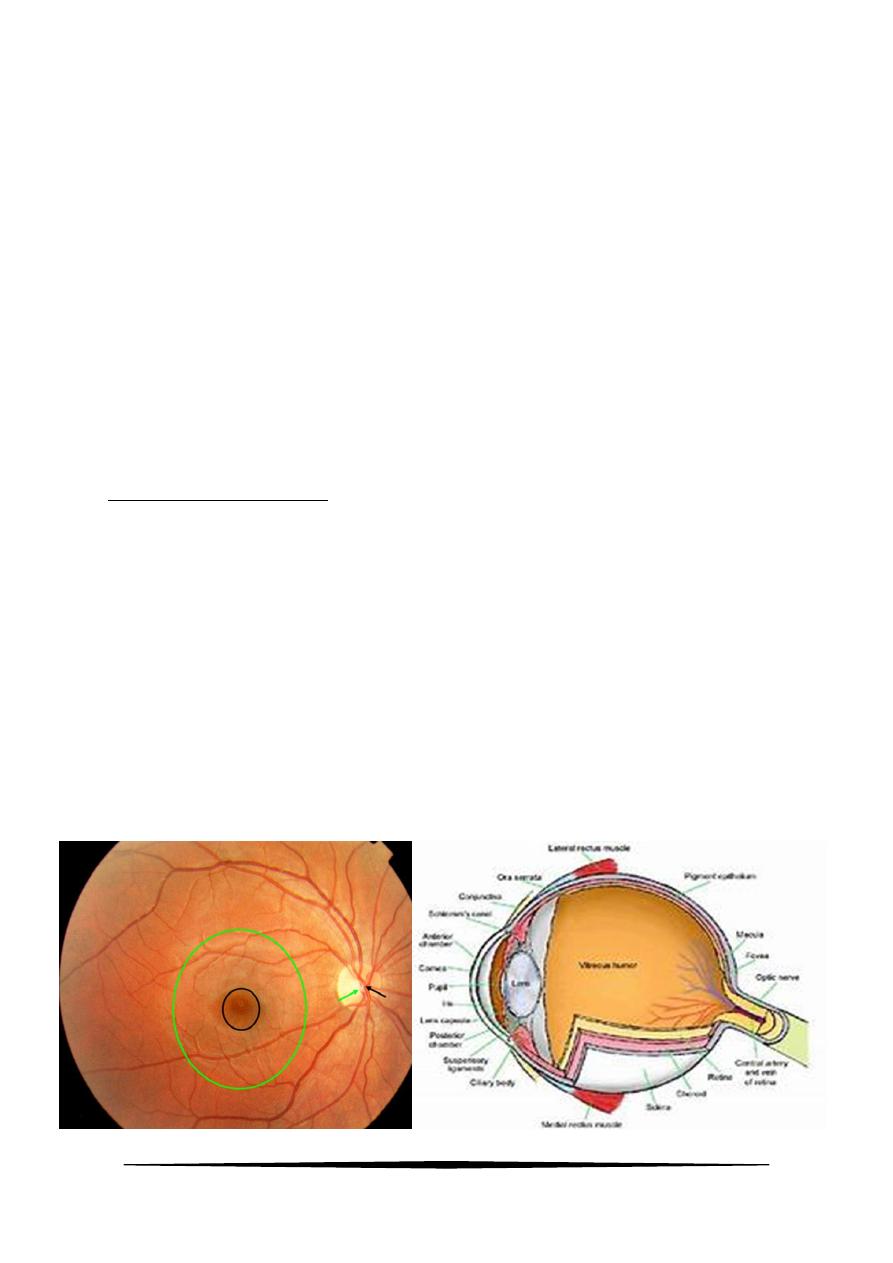
19
Nerve supply:
The sphincter pupillae is supplied by parasympathetic fibers from the oculomotor
nerve.
dilator pupillae is supplied by sympathetic fibers, which pass forward to the
eyeball in the long ciliary nerves.
Action:
The sphincter pupillae constricts the pupil in the presence of bright light and during
accommodation.
The dilator pupillae dilates the pupil in the presence of light of low intensity or in
the presence of excessive sympathetic activity.
Nervous Coat: The Retina
The retina consists of an outer pigmented layer and an inner nervous layer. Its outer surface
is in contact with the choroid, and its inner surface is in contact with the vitreous body. Its
anterior edge forms a wavy ring called the ora serrata.
At the center of the posterior part of the retina is an oval, yellowish area, the macula lutea,
which is the area of the retina for the most distinct vision. It has a central depression, the
fovea centralis.
The optic nerve leaves the retina about 3 mm to the medial side of the macula lutea by the
optic disc. The optic disc is slightly depressed at its center, where it is pierced by the central
artery of the retina.
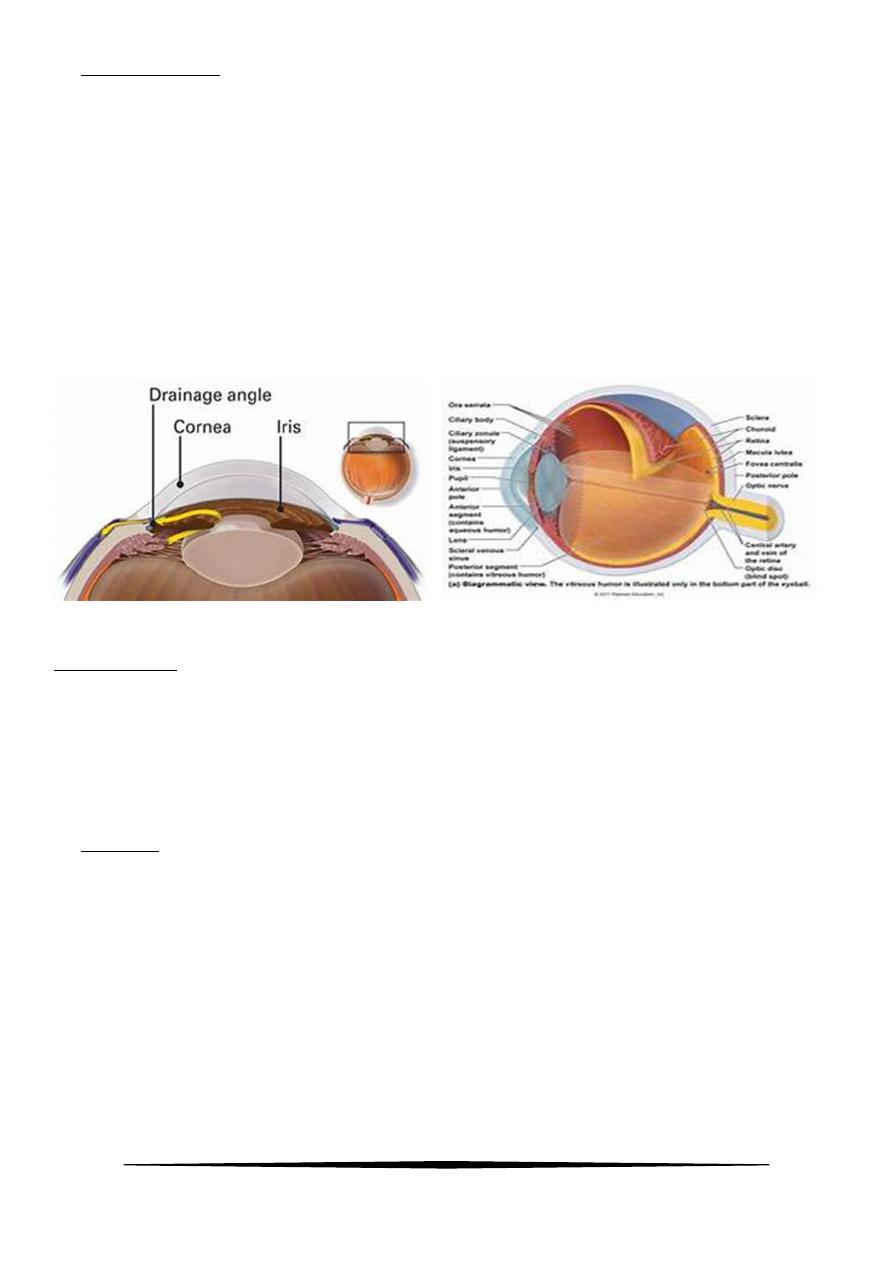
21
Aqueous Humor
The aqueous humor is a clear fluid that fills the anterior and posterior chambers of the
eyeball. It is believed to be a secretion from the ciliary processes, from which it enters the
posterior chamber. It then flows into the anterior chamber through the pupil and is drained
away through the spaces at the iridocorneal angle into the canal of Schlemm.
The function of the aqueous humor is to support the wall of the eyeball by exerting internal
pressure and thus maintaining its optical shape. It also nourishes the cornea and the lens and
removes the products of metabolism; these functions are important because the cornea and
the lens do not possess a blood supply.
Vitreous Body
The vitreous body fills the eyeball behind the lens and is a transparent gel.
The function of the vitreous body is to contribute slightly to the magnifying power of the
eye. It supports the posterior surface of the lens and assists in holding the neural part of the
retina against the pigmented part of the retina.
The Lens
The lens is a transparent, biconvex structure enclosed in a transparent capsule. It is situated
behind the iris and in front of the vitreous body and is encircled by the ciliary processes.
